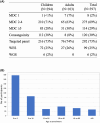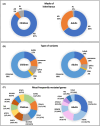Primary mitochondrial disorders and mimics: Insights from a large French cohort
- PMID: 38703036
- PMCID: PMC11187946
- DOI: 10.1002/acn3.52062
Primary mitochondrial disorders and mimics: Insights from a large French cohort
Abstract
Objective: The objective of this study was to evaluate the implementation of NGS within the French mitochondrial network, MitoDiag, from targeted gene panels to whole exome sequencing (WES) or whole genome sequencing (WGS) focusing on mitochondrial nuclear-encoded genes.
Methods: Over 2000 patients suspected of Primary Mitochondrial Diseases (PMD) were sequenced by either targeted gene panels, WES or WGS within MitoDiag. We described the clinical, biochemical, and molecular data of 397 genetically confirmed patients, comprising 294 children and 103 adults, carrying pathogenic or likely pathogenic variants in nuclear-encoded genes.
Results: The cohort exhibited a large genetic heterogeneity, with the identification of 172 distinct genes and 253 novel variants. Among children, a notable prevalence of pathogenic variants in genes associated with oxidative phosphorylation (OXPHOS) functions and mitochondrial translation was observed. In adults, pathogenic variants were primarily identified in genes linked to mtDNA maintenance. Additionally, a substantial proportion of patients (54% (42/78) and 48% (13/27) in children and adults, respectively), undergoing WES or WGS testing displayed PMD mimics, representing pathologies that clinically resemble mitochondrial diseases.
Interpretation: We reported the largest French cohort of patients suspected of PMD with pathogenic variants in nuclear genes. We have emphasized the clinical complexity of PMD and the challenges associated with recognizing and distinguishing them from other pathologies, particularly neuromuscular disorders. We confirmed that WES/WGS, instead of panel approach, was more valuable to identify the genetic basis in patients with "possible" PMD and we provided a genetic testing flowchart to guide physicians in their diagnostic strategy.
© 2024 The Authors. Annals of Clinical and Translational Neurology published by Wiley Periodicals LLC on behalf of American Neurological Association.
Conflict of interest statement
The authors declare no competing financial interest.
Figures





References
-
- Schaefer AM, Taylor RW, Turnbull DM, Chinnery PF. The epidemiology of mitochondrial disorders—past, present and future. Biochim Biophys Acta. 2004;1659(2–3):115‐120. - PubMed
-
- Morava E, van den Heuvel L, Hol F, et al. Mitochondrial disease criteria: diagnostic applications in children. Neurology. 2006;67(10):1823‐1826. - PubMed
MeSH terms
Substances
LinkOut - more resources
Full Text Sources
Medical
Molecular Biology Databases

